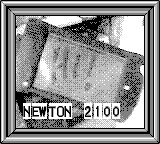En el Blog de
Genghis7777 dice que segun la wiki, se pueden mandar paquetes directo desde windows de la siguiente manera (aunque el dueño del blog lo probó pero no le funcionó, vamos a ver que pasa, pero creo que es más probable tratando con Mac Os ):
Windows 2000
1. Run 'irftp' from the Start->Run... box,
2. browse
to the file you want to send but don't send it yet!
3. Line up the Newton's IR port
with the PC.
4. Open the In/Out box on the Newton and
5. tap 'Recieve -> IrOBEX'.
6. In a second you should get a notification in the taskbar on the PC that it has
detected the IR connection. NOW click Send on the PC and the file will be sent.
Windows XP
1. Open the In/Out box, and click "receive", then
2. line up the IR ports the Wireless Connection dialog box should
automatically open (no need to run 'irftp').
Por otro lado, siguiendo con la emulacion de Mac OS 9, ya bajé todo y funciona. Pero no sé como abrir el archivo necesario alojado en Windows. Probé de conectarme a internet desde Mac para bajarlo, pero no pude, a pesar de haberlo configurado...
PROXIMAMENTE MÁS NOVEDADES
![]()









